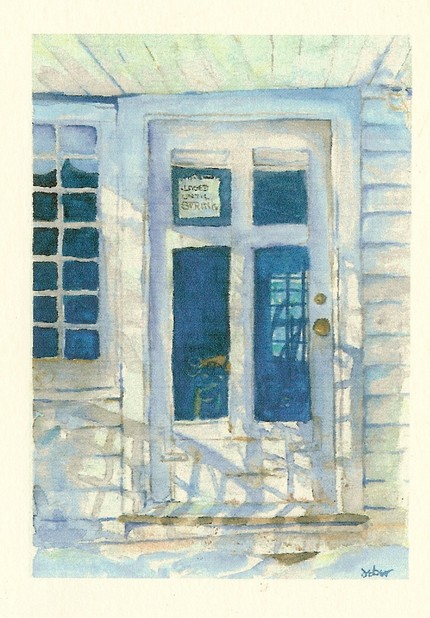Well, once upon a time, I found a chunk of a dead limb that had fallen from one of the above mentioned oak trees during a storm. Ferns clung to it for dear life, not realizing that their anchor was destined for the trash pile. Neither did the two tiny fairies who were recklessly dancing along amongst the fronds. (But that's another story...)
Being a nut for houseplants, I took my free plant home and put it on the stoop out back, where my houseplants lived in the summertime. I had no idea what to do with it yet, but I was excited. I would think of something. Of course, I was a busy girl, and by the time I got back to my lovely green treasure, it was an ugly shriveled mess. I promptly tossed it out.
Ah, but I had acted hastily, dear reader. Unfortunately, I hadn't realized that this lovely little fern, like the possums that live in the woods nearby, likes to play dead. The leaves curl up and appear to be turning brown, but that is just its way of telling the world that it's thirsty. As soon as it gets even a small drink of water, the leathery fronds perk up and show off with broad palate of lush green.It's no surprise that someone decided to call this resilient, wild fern the "Resurrection Fern". And since many of us are celebrating the season of Lent right now, it seems like a really cool time for me to write about this rugged little plant. (Especially in Mobile, just after Mardi Gras, when the oaks, still draped with dozens of bright colored beads, glisten in the sunlight with every new breath of Spring.)
Bring one inside for Easter. What a nice way to tie the resurrection of Christ to an activity you and your children could do together. The resurrection, the living water, and being born again.
The Resurrection Fern is an "epiphyte", or a plant that attaches itself to a rock or tree or other support, using trailing stems, similar to an orchid or a bromeliad. It doesn't live like a parasite, sapping strength from its support. Instead, it is watered by the rain, and is fed by debris that washes onto it's roots from its anchor of choice.
Also like orchids and bromeliads, these trailing ferns can be mounted on wood or rocks, and displayed in a window that gets filtered light (like the light they would get, shaded by upper branches in an oak tree.) And because they are so small, they are perfect for terrariums and the newest craze, the "Fairy Garden".
I'd like to share with you what I did just yesterday, with one of the small pieces Bill and I rescued from the debris at the base of a public street side tree:
First, I studied the chunk of fern which was already well anchored to the piece of wood I found it on, and I decided what would look best "up" and "front". (As you can see, one of my china girls and a wooden cat decided to stop in and watch.)
I have a roll of black wire used in construction for tying rebar, which I bought at Home Depot a while back. I use it for all kinds of projects. (It will rust, but I like that quality. You may prefer to use copper, brass, or any other sturdy, but pliable wire.) I cut a piece about 9" long, and pushed one end into one upper side of the wood, until it came out the other side. This was easy in this dead piece of branch. Otherwise, I would have drilled a hole through the middle for the wire to be inserted through. Using my jewelry tools, I made a hook with the wire, where it came out of the wood.
As in the picture above, I brought the wire over the top of the piece of wood, and made a loop at the top to use as a hanger, attaching the remaining wire to the "hook" I had made on the other side.
Next, I cut some pieces of wire, about 4 or 5 inches in length, and curled each end. (You could make them longer, depending on what suits your fancy.) They hook together nicely to form a chain. I ended up straightening out the first loop a bit, so I can easily remove the plant from the chain for watering.
Since we are in a rental, I used a "nail free" hook to hang it from a bathroom window frame, where it will get plenty of humidity, morning sun, and where I will see it often enough to keep it watered, because though it can go quite a while without water, it will need to be watered fairly often to keep it healthy and beautiful.
Voila, my friends! One of the easiest things I've ever made, and so pretty, too.
I am going to start by watering my ferns once a week, or whenever they seem to be wilting. Whenever possible, I will water them by dunking them into a fish pond, because the fish water will help nourish the ferns. If you don't have a fish pond, you may want to spritz your fern with a little orchid fertilizer, or a mild solution of fish emulsion...but fish emulsion is stinky, so keep that in mind, if that is your choice. You also can leave your fern outside for the summer, under a tree limb.
To find your own Resurrection Fern, keep your head up and your eyes peeled. When you do find one, I'd love to see what you do with yours! If it doesn't grow in your area, you can buy it on Ebay. Just google "buy a Resurrection Fern". They are not expensive.
I am working on a follow up post, to show you how to mount one of these cuties to a piece of wood. I have this great knothole that I found the other day! I'm thinking, ferny bird house...if only I had wings...
Until we meet again, my ferns...I mean, friends. Heads up, eyes peeled. Think Resurrection.
Happy trailing ferns to you!
UPDATE;
After just two days hanging in the window, I realize that my little fern is a very thirsty girl...or boy. I found it this morning in this condition:
In a word, "Shriveled". In another word, "Already."
So I took it out to the pond in the garden here (where we are renting temporarily), dipped it, and brought it inside. When I get back home, I do have a small pond which will be great for a once-a-month watering (to nourish it), but it isn't in an easy to reach location.
So, it would be easy to water in the shower or using the kitchen spray. The biggest thing is not forgetting about it. It will be fine for a few days, and maybe even weeks, but I am not going to take any chances. I will water it every day or two. The others will need a terrarium, where the atmosphere can be kept more constant.


































